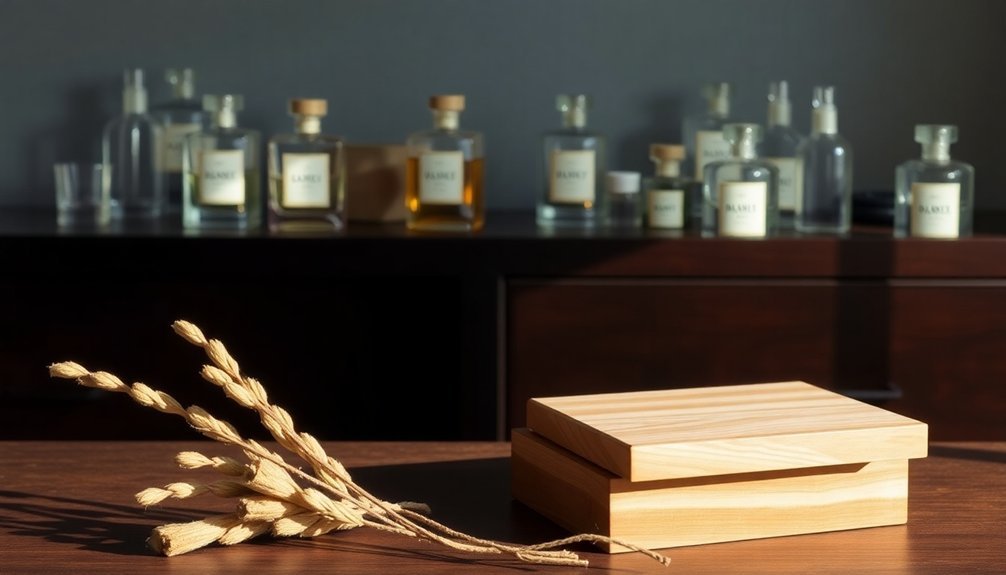Sandalwood's unique molecular structure makes it your best choice for creating lasting perfumes. You'll find its heavy molecules break down slowly on your skin, providing up to 24 hours of sophisticated fragrance. It blends beautifully with florals, spices, and sweet notes while adding depth and warmth to any scent combination. Apply it to moisturized skin for ideal longevity, and pair it with complementary fragrances like rose or vanilla. Discover why perfumers consider this versatile ingredient their secret weapon for signature scents.
The Science Behind Sandalwood's Lasting Power

Science explains why sandalwood stands as a cornerstone in long-lasting perfumes. Its complex molecular structure breaks down slowly on your skin, creating a fragrance that can last up to 24 hours.
Unlike citrus and floral notes that quickly evaporate, sandalwood's heavy molecules and low volatility guarantee the scent lingers throughout the day.
You'll find that sandalwood's effectiveness comes from its remarkable interaction with skin chemistry. If you have oily skin, you're in luck – the natural oils help retain the fragrance longer. Its reputation as a popular base note in commercial fragrances is well-deserved.
While dry skin may cause the scent to fade faster, you can extend its wear by moisturizing before application.
When perfumers combine sandalwood with other base notes like amber or musk, they create an even more enduring fragrance profile that enhances the overall longevity of your perfume.
Natural Vs Synthetic Sandalwood Properties
While the lasting power of sandalwood makes it desirable in perfumery, understanding the differences between natural and synthetic variants can help you make informed fragrance choices.
Natural sandalwood, sourced from Santalum trees, contains 230 molecules and offers a warm, milky, powdery scent that's deeply complex. You'll find quality natural sandalwood contains at least 90% santalol, creating that distinctive aroma you might associate with Asian temples. The oil requires steam distillation process that can take up to 5 days to complete.
Synthetic alternatives like Ebanol, Javanol, and Firsantol each bring unique characteristics to the table. You'll notice Ebanol is three times more potent than natural oil, with chocolate undertones, while Javanol better mimics the musky aspects.
Though synthetics can't fully replicate natural sandalwood's nuanced profile, they're more cost-effective and environmentally sustainable, making them practical alternatives in modern perfumery.
Essential Blending Techniques With Sandalwood

When you're working with sandalwood as your base note, start by pairing it with complementary scents like rose, jasmine, or citrus to create a balanced fragrance profile.
You'll want to layer your fragrances strategically, applying sandalwood first and following with lighter notes to maximize the perfume's longevity. Always allow fragrances to dry between layers for optimal blending.
To achieve the perfect blend, balance the sweet and woody elements by testing combinations on paper first, ensuring the sandalwood doesn't overpower your chosen companion scents.
Complementary Notes for Sandalwood
To create alluring sandalwood perfumes that stand the test of time, you'll need to master the art of blending complementary notes. Sandalwood's versatile nature allows it to pair beautifully with various fragrance families, each bringing unique characteristics to your final creation.
| Category | Notes | Effect |
|---|---|---|
| Floral | Rose, Jasmine | Romantic, sophisticated |
| Citrus | Bergamot, Orange | Fresh, invigorating |
| Spicy | Cinnamon, Cardamom | Warm, mysterious |
| Woody | Cedarwood, Vetiver | Earthy, grounding |
| Oriental | Vanilla, Amber | Sweet, enchanting |
You'll find that floral notes add elegance, while citrus brings brightness. Spicy elements create depth, woody notes enhance earthiness, and oriental additions provide warmth. Consider starting with one note from each category to develop a complex, well-rounded fragrance that showcases sandalwood's full potential.
Layering Techniques for Longevity
Mastering the art of fragrance layering transforms a simple sandalwood perfume into a long-lasting masterpiece. Start by applying sandalwood as your base note on moisturized skin, focusing on pulse points like your wrists, neck, and behind your ears. This powerful foundation will anchor your fragrance combination throughout the day.
When layering additional scents, work from strongest to weakest. You'll want to apply lighter fragrances first, then layer your sandalwood-based scent on top. Before combining different perfumes, test them on paper to verify they complement each other well.
Don't rub the fragrance into your skin; instead, gently dab or spritz it on.
Store your sandalwood perfume in a cool, dry place away from sunlight to preserve its potency, and consider using matching scented lotions to enhance its longevity.
Balancing Sweet and Woody
The delicate balance between sweet and woody notes creates the foundation for exceptional sandalwood fragrances.
You'll find that vanilla and tonka bean naturally complement sandalwood's earthy essence, producing a warm, luxurious finish that's perfect for winter evenings.
For daytime wear, try combining sandalwood with citrus notes like bergamot or grapefruit to achieve an energizing and fresh profile.
- Floral pairings with jasmine or rose create sophisticated, timeless scents ideal for special occasions
- Spice notes such as cinnamon and cardamom add mystery and warmth, perfect for intimate settings
- Sweet combinations with vanilla and honey amber deliver a cozy, inviting atmosphere
- Citrus blends offer a clean, invigorating touch that's excellent for casual daytime activities
Experiment with these combinations to discover your perfect sandalwood blend, whether you're seeking something romantic, fresh, or mysteriously exotic.
Creating Signature Scents Using Sandalwood Base
When creating your signature scent with sandalwood, you'll discover an extraordinary base note that offers both versatility and staying power. You can blend it with vanilla, bergamot, or citrus to craft a unique fragrance that lasts 12-24 hours on your skin.
To develop your perfect scent, start by testing how sandalwood interacts with your body chemistry. Its creamy undertones will enhance other fragrances while providing a sophisticated foundation.
You'll find it works beautifully for any occasion, from casual daytime wear to formal evening events.
Consider layering sandalwood with aromatic spices or floral notes to create depth. Since it's harvested from mature trees aged 30-50 years, choose high-quality sandalwood perfumes for the best results.
The investment's worth it – you're tapping into centuries of perfumery tradition while crafting something uniquely yours.
Storage Tips for Sandalwood-Based Fragrances

You'll maximize your sandalwood perfume's longevity by storing it in a cool, dark place between 41°F and 65°F, preferably in its original box or a dedicated perfume cabinet.
To protect your fragrance from degradation, keep it away from bathrooms, direct sunlight, and heat sources like radiators or windowsills.
Maintaining consistent storage conditions and keeping the bottle tightly sealed will preserve the rich, woody notes of your sandalwood-based scent for years to come.
Optimal Storage Conditions
Proper storage of sandalwood-based fragrances can considerably extend their lifespan and maintain their distinctive aroma.
You'll want to keep your perfume in a cool environment between 55-65°F (13-18°C), away from temperature fluctuations that can break down its delicate compounds. A dark, dry cabinet is your best storage solution, as it protects against both sunlight and humidity that can alter the scent's character.
- Keep bottles tightly sealed to prevent oxidation and preserve the fragrance's integrity
- Store perfumes in their original packaging for additional protection from light
- Avoid bathroom storage, where humidity from showers can affect the scent
- Choose a stable environment away from windows and heat sources
Remember to minimize how often you open the bottle, as repeated air exposure can impact your perfume's quality over time.
Extending Fragrance Life
Understanding sandalwood's natural fixative properties makes it an ideal base for creating long-lasting fragrances. You'll get the most longevity from your sandalwood perfume by choosing higher concentrations, like Eau de Parfum, which contains more fragrance oils than Eau de Toilette.
To extend your fragrance's life, try layering techniques. You can start with a sandalwood-based layering oil before applying your perfume. This method prevents over-spraying while maintaining the scent throughout the day.
When selecting fragrances, look for those that blend sandalwood with complementary notes like vanilla, bergamot, or patchouli. These combinations not only create depth but also enhance the perfume's staying power. The sesquiterpenes in sandalwood help stabilize these additional notes, ensuring your fragrance remains consistent and enchanting from morning to night.
Popular Perfume Combinations With Sandalwood
When combined with other fragrance notes, sandalwood's versatile woody aroma creates stunning perfume combinations that range from floral and romantic to spicy and sensual.
You'll find this remarkable ingredient paired with everything from delicate florals like rose and jasmine to bright citruses like bergamot and lemon. For deep, meditative scents, it's often blended with frankincense or myrrh, while combinations with vanilla or musk create sensual, modern fragrances.
- Floral pairings like rose and jasmine enhance sandalwood's romantic qualities while maintaining its sophistication
- Woody blends with cedarwood or vetiver create deep, forest-like aromas
- Citrus combinations featuring bergamot or lemon add brightness to sandalwood's depth
- Spicy-sweet pairings with vanilla or cardamom produce rich, seductive scents perfect for evening wear
Frequently Asked Questions
Can People With Sensitive Skin Safely Use Sandalwood-Based Perfumes?
You can use sandalwood perfumes if you've got sensitive skin, but always do a patch test first. Choose organic formulations and use them sparingly. Stop using immediately if irritation occurs and consult your doctor.
Does Authentic Sandalwood Oil Have Any Aromatherapy Benefits?
Yes, authentic sandalwood oil offers you significant aromatherapy benefits. You'll experience reduced anxiety, lower blood pressure, better sleep quality, and improved mood. It's also great for promoting mental clarity and emotional balance.
Why Is Indian Sandalwood More Expensive Than Australian Sandalwood?
You'll find Indian sandalwood costs more because it's rarer, has higher quality heartwood, and faces greater demand. Its production has dropped considerably while global demand remains high, pushing prices well above Australian varieties.
How Can You Identify Fake Sandalwood Perfumes in the Market?
You can identify fake sandalwood perfumes by checking for authentic vendor stamps, performing the water sink test, evaluating the subtle fragrance, and looking for synthetic, overpowering scents that quickly fade without returning.
Do Sandalwood-Based Perfumes Smell Different on Different Skin Types?
Yes, your skin type greatly affects how sandalwood perfumes smell. You'll notice it lasts longer on oily skin, needs stronger concentrations for dry skin, and maintains true notes on normal skin types.
In Summary
Now you've learned why sandalwood is the go-to base note for lasting fragrances. Whether you're working with natural or synthetic varieties, you'll find that sandalwood's rich, woody aroma creates the perfect foundation for your signature scent. Remember to store your sandalwood perfumes properly and experiment with different combinations to discover your ideal blend. You're ready to start creating memorable fragrances that'll truly stand the test of time.





Leave a Reply